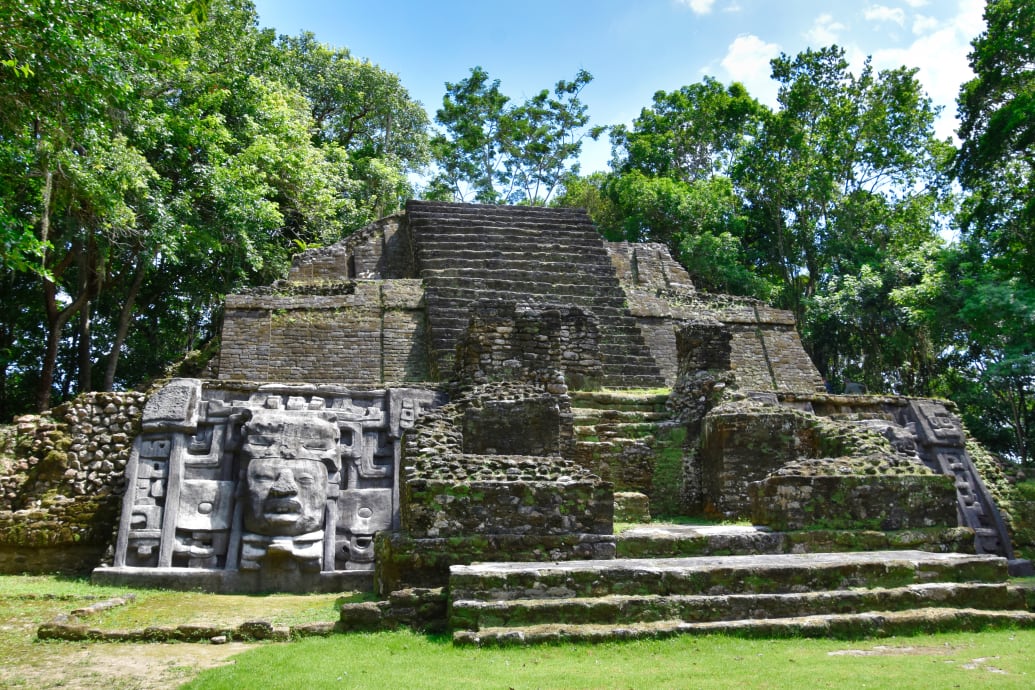Ship. Boat. Bus. Boat. Walk.
That’s how I made it to Lamanai, an ancient Mayan city reservation in Northern Belize that was the longest occupied of the Mayan world (3000 years). In Mayan, Lamanai means “submerged crocodile,” which fits as it sits along the lush and green crocodile waters of the New River that took us there.
Climbing a stepped Mayan temple, like Mask Temple, is a bucket-lister for me. Mask Temple houses a tomb and is flanked on the left and right by two faces (fiberglass replicas of the originals). The original faces are made of limestone and sit behind them for protection. As a kid, I always imagined an Indiana Jones-esq adventure at a Mayan temple. This was far more tame, of course—after stealing someone else’s national treasures, Dr. Jones wouldn’t have rated his adventures on TripAdvisor. After visiting three temples, we started our return.
Mask Temple, Lamanai Belize
Photo courtesy of Brandon Withrow
Walk. Boat. Bus. Boat. Ship.
This ship we returned to, however, is not just any ship; it’s the MS Roald Amundsen, the world’s first battery-hybrid cruise ship, and part of the Norwegian fleet, Hurtigruten Expeditions. At a capacity of only 530, the Roald Amundsen is not your usual floating city. From collecting scientific data to visiting protected spaces, Hurtigruten exchanges the nightly stand-up acts of other cruise lines for lectures on sea turtles, sustainability, and citizen science.
This was a cruise for science and nature lovers—and that is why I was here.
At the invitation of Hurtigruten Expeditions, I joined them for their “Caribbean Vibes & Ocean Exploration” package (from $4,064), which starts in Miami and includes stops in Belize, Nicaragua, and Panama.
Those Caribbean vibes did get a little interrupted.
Due to Hurricane Ian, which we flew around on our way down, we were also delayed a day waiting on a resupply in Miami, meaning a day was cut from the itinerary, and as a result, we lost our birding stop at the uninhabited Half Moon Caye island in the Lighthouse Reef. COVID restrictions in Nicaragua also meant we couldn’t visit Big Corn Island. Instead we stopped at the Columbian island of San Andres, which is part of an archipelago that includes the small island of Providencia and Santa Catalina. San Andres served as a base for the real Captain Morgan and is said be where he hid his treasure.
All of Hurtigruten’s trips are intended to be sustainable—travel that gives back what it takes, funds conservation, encourages diversity, and empowers local communities economically and culturally. This plays out in how they run the ship and plan their destinations.
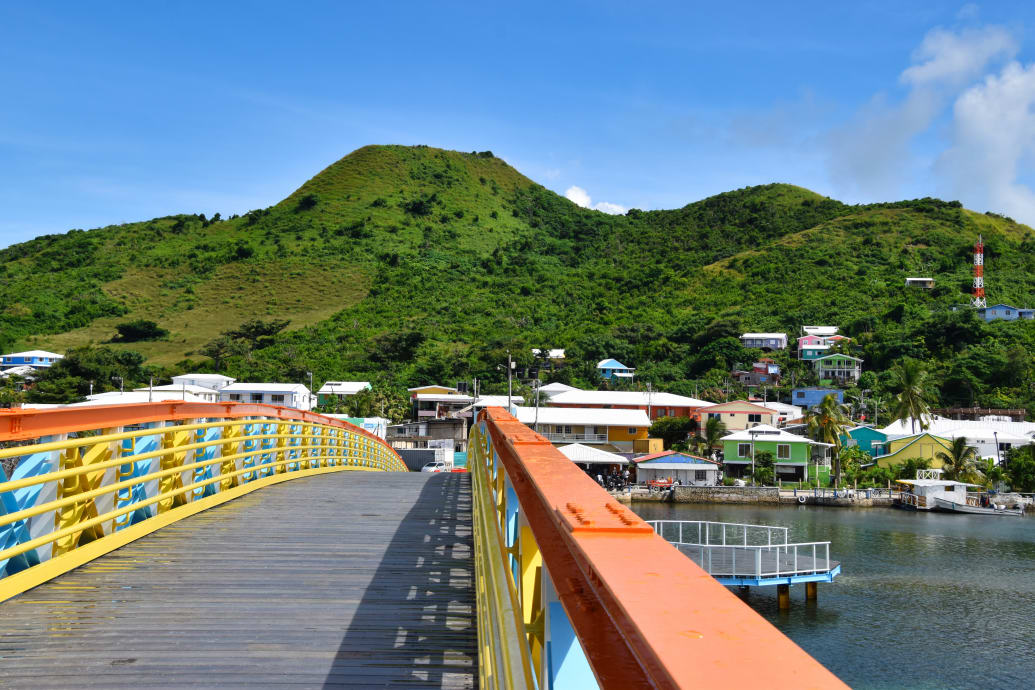
Isla de Providencia
Photo courtesy of Brandon Withrow
Isla de Providencia, for example, is a stunning little island—and was also a favorite hideout for Captain Morgan. It has bright green hills set against vibrant blue waters. It’s idyllic and friendly. In 2020, Providencia lost upwards of 98 percent of its infrastructure due to Hurricane Iota. When we arrived, they were only half-way back to rebuilding. Their mangroves, which help buffer the coast in a storm, were in the process of restoration. What the community needs is tourism dollars to bolster their economy.
While all exploration and adventure, like supporting the preservation of Mayan cultural sites or stopping at Providencia with tourism dollars, are done with sustainability in mind, for Hurtigruten their proud example of sustainability starts at home with the ship itself.
So, okay fellow nerds—ready to explore the ship’s engine room?
Named after the Norwegian explorer, Roald Amundsen—the first to cross Antarctica, reach the South Pole, and voyage through the Northwest Passage—the ship is designed for exploring polar waters. Its larger tenders and smaller Zodiacs take passengers to see uninhabited islands, national parks, and wildlife. In fact, while the Caribbean and Central America trip happens once a year, as the ship moves from North to South Pole and back again, passengers can now join their Pole-to-Pole Expedition (starting at just over $42,000 USD), which range from 66-94 days in length.
The Roald Amundsen is small by comparison to most cruise ships, which is the only reason I’d even consider going. Due to the hurricane, we ended up with only just over 200 passengers. For comparison, we were in port in Miami next to the Royal Caribbean “Freedom of the Seas,” which can hold 4,635 guests with 1,365 crew members and features water slides.
“We’re like a baby ship next to it,” I heard a passenger say.
This December, Royal Caribbean will launch their newest monster, Icon of the Seas, which will—hold onto your butts—carry 10,000 passengers and crew. I’m of the opinion that ship size will correlate to how misanthropic I feel—and how well a ship can actually be sustainable.
The MS Roald Amundsen isn’t equipped with water-slides and putt-putt courses, but it does have a lot going for it—like not having water slides and putt-putt courses. (They do have hot tubs and an infinity pool with a full bar—they’re not monsters.) In 2019, it made headlines when it became the world’s first battery-hybrid ship. The words “Hybrid Powered” in blue letters stand out against its white, red, and black hull.
So what about those sexy batteries?
“Thirty minutes,” I was told during an exclusive tour of the ship’s control and engine rooms. That’s how long the ship could go on batteries alone—something they tested in Alaska.
The main role of the batteries is far more practical, however. If the bridge called for a high load, I was told, the batteries would take over that extra demand to keep the traditional engines stabilized, and from burning excessive fuel. The batteries also support functions across the ship. The battery room is a wall of white-plated batteries, reminiscent of a server room.
According to Hurtigruten, the combination of batteries and biofuels—they stopped using heavy fuels ten years ago—has enabled them to reduce their carbon emissions by more than 20 percent. Part of that reduction also comes from their heat recovery systems, where heat from the water that cools the engines is used to heat the ship, showers, ventilation, and pools. Exhaust gas also works as another heat source.
Being a zero-emissions cruise line is Hurtigruten’s next goal.
Hurtigruten Expeditions’ sister company, Hurtigruten Norway, announced their plans to have a zero emissions ship by 2030—a benchmark set with the global Paris Agreement on climate goals—which may serve as a model going forward fleet-wide.
Hurtigruten, however, doesn’t sacrifice luxury and adventure for efficiency.
As both my home and my ride, the MS Roald Amundsen was a comfortable base for exploration. All cabins of the ship are outside cabins, meaning they have windows that face the sea, with 50 percent having balconies. Rooms to the aft have private balconies and hot tubs. My room was an Arctic Superior suite, which has a comfortable double bed, is spacious, comes with a balcony, and ample closet space next to a nicely arranged, spacious bathroom with a step-in shower. The ship uses beautiful and light Scandinavian materials (granite, oak, birch and wool) throughout. My room came with laundry services with a one-day turnaround, which helps to reduce the tendency to overpack.
As with many luxury hotels, they use environmentally safe soaps and there is a green stay option for passengers who can opt out of having their towels and rooms cleaned every day (saving on water). For those that do that, Hurtigruten Expeditions goes a step further than most hotels and makes a small donation of half a euro (per room, per day) to the Hurtigruten Foundation, which funds projects to fight climate change, pollution, and unsustainable mass tourism.
Wellness services, like their sauna and spa, are available for passengers, particularly for those days when you’re back at the ship after being out on the Zodiacs skipping across the sea, or hiking, or climbing or, (I guess) even if you want to recuperate after a restful day on a Caribbean beach.
Their move towards sustainability means they have a fleet-wide ban on plastics—so passengers are given reusable water bottles, which can be filled at multiple points on the ship. The bottles, however, don’t stay as chilled in the Caribbean weather as I imagine they do when traveling in polar environments. That the ship is primarily designed with cold weather in mind is also apparent in the store, where cold-weather clothing is stocked most.
When you board you are also immediately stopped in your tracks by an impressive multi-floor—roughly 57.5 foot—LED screen that displays videos of the ship’s polar journeys in Ultra-HD while you ride the elevators.
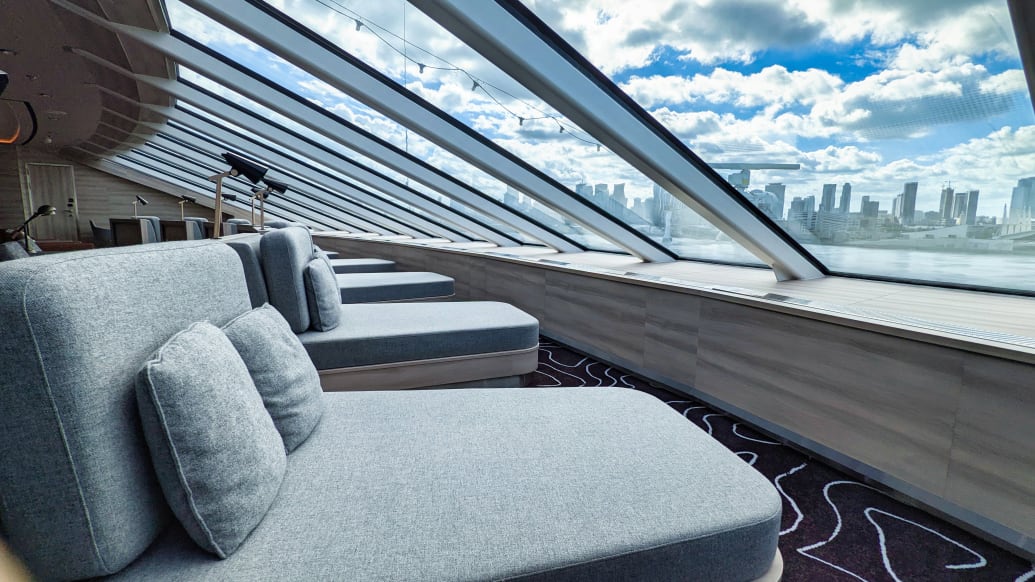
Explorer Lounge on the MS Roald Amundsen
Photo courtesy of Brandon Withrow
On 10 forward is the stylish Explorer Lounge. (Yes, I did just call it 10 Forward the entire time because that was the name of the lounge on Star Trek: TNG—and like the Enterprise, this is a science-focused ship.) The lounge is a large space wrapped in windows and comfortable seating, with a wide row of chaise lounges facing the bow. The full bar offers anything you’d want and it doesn’t have to be five o’clock somewhere to imbibe—though it does have espresso if you decide to drink like it’s five o’clock everywhere.
There are three restaurants: Aune, Fredheim, and Lindstrøm. The ship’s app, which allows you to track your registered excursions and other events, also features the menus for each restaurant. The least formal of the three is Fredheim, which has more American fare and can get packed, largely due to their milkshakes which you can get with alcohol.
Aune is less informal than Fredheim in both setting and menu, but no one is expected to dress up. Because this is an expedition cruise, there is never an expectation to dress up. Most people wear athleisure, unless they are getting drinks at night at the Explorer Lounge. Meals at Aune are mostly a buffet, though not always, and there might be a night with a fixed menu. The food is always fresh. Lindstrøm is a more formal setting with an elevated dining experience and attentive service.
When it comes to food, a sustainable menu is about lowering the footprint of your supply.
“We aim to source locally and regionally wherever we explore,” said Stefan Engl, Director Hotel Operations. “Hurtigruten Expedition looks to purchase up to 80 percent of all our food products locally in key turnaround ports.” Engl tells me that they sourced more than 80 percent locally during their Alaska season and they connect with local suppliers elsewhere as well to reduce the global shipping required for supply and to support local communities. They also see themselves as offering the most plant-based options in the cruise industry.
As part of Hurtigruten’s concern for the environment, the MS Roald Amundsen is also on a scientific mission with its own scientists on board. The ship gathers data about the ocean and its team encourages and educates passengers on how to do citizen science.
Tracking whales? Visit Happy Whales. Are you a birder? Download Merlin and eBird to identify and record sightings. Looking at plants and other animal life? Check out iNaturalist. You might even alert scientists to bird migration changes or an invasive plant species.
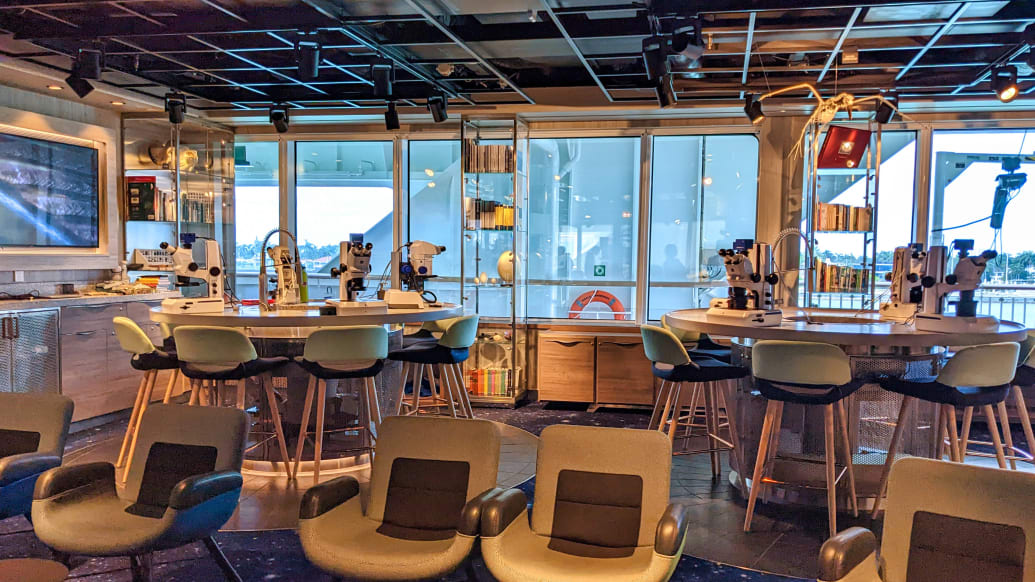
Microscopes in the Science Center on the MS Roald Amundsen
Photo courtesy of Brandon Withrow
The heart of this is their science center, where you’ll find microscopes, and samples to look at under them, as well as books on the wildlife you’ll encounter, charts on how to identify whales, and a touch screen that shows you the science being collected by the ship and shared with data centers, like ocean currents and temperatures, tracking oil spills, and microplastics levels. Attached to the Science Center is a hall where passengers are not only briefed on the next day’s excursions, but also come to hear talks on subjects like sea turtles, whales, and birds and coral reefs.
Connected to the Science Center is the two-story indoor-outdoor Observation Deck. From there you can track birds and marine mammals. The ship’s ornithologist, Brendan Murtha—they have their own ornithologist—could be found there helping passengers identify species, like the magnificent frigate bird (yes, that’s its name and it is magnificent), the brown booby or the masked booby or the red footed booby. (Also, yes, when birders talk about boobies, everyone turns into a fifth grader.)
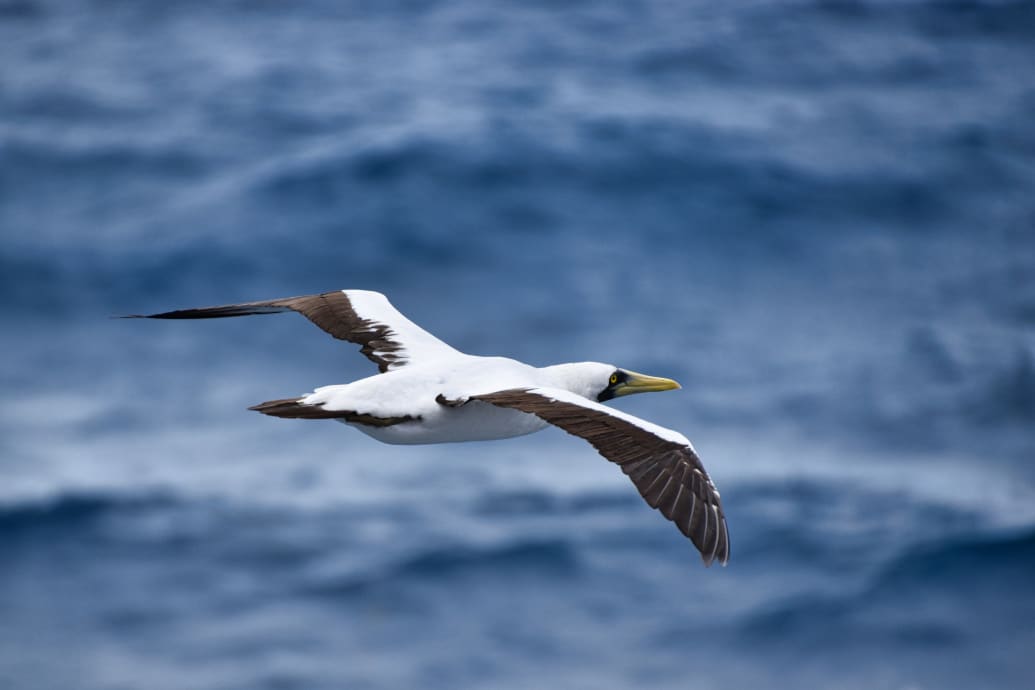
Masked Booby off the bow of the MS Roald Amundsen
Photo courtesy of Brandon Withrow
But getting off the ship and exploring is why everyone is there. Adventures are usually just a tender away. Hurtigruten’s itineraries are designed to showcase UNESCO sites and support wildlife conservation, put tourism dollars into lesser visited destinations, which helps local communities. Once off ship though, sustainability is at the mercy of which local partners deliver you to destinations. Not everyone can afford hybrid technology.
Our last excursion will always stay with me: the Oreba Chocolate Tour.
Ship. Zodiac. Boat. Van.
In the tropical rainforests of Bocas Del Toro, Panama, we hopped out of the van to meet the Indigenous farmers who run the chocolate tour. They greeted us with a plate of fresh fruit and then took us on a tour of the property, sloshing over soaked paths to see how they make chocolate from the cacao fruit.

Oreba Chocolate Tour, Bocas del Toro, Panama
Photo courtesy of Brandon Withrow
It rained. Then stopped. Then it rained some more. I stepped past a mealy parrot that stayed dry under an overhang and never stopped staring at me. We were drenched. The forest air was wonderful.
Our hosts took a machete and sliced open the fruit, giving us a sample of the cacao seed. It was slimy, but sweet. They roasted seeds, set them on a large stone, and then rolled them over using another large hand-held stone—some members of our group also took a stab at it. It became a fine, smooth, chocolate paste. We finished off the tour with hot chocolate.
Excursions like this are an opportunity for cultural exchange and to support the community. Before we left, we stopped in their store to take some chocolate home with us. I love this kind of exploration. It is time in a forest that I don’t have at home with people whose lives are far different from mine. It is a chance to expand my view of the world before I…
Van. Boat. Zodiac—back to the ship.
The next day, we said goodbye to our floating home and its friendly crew. We arrived in Panama City for our flight home and there was some deja vu. Hurricane Julia was heading straight across in our flight path. It was also heading to San Andrés and Providencia, which felt its 75 mph winds, but managed to avoid a repeat of Iota. Our pilot told us we’d be flying around the storm—again.
We came full-circle.

